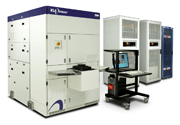Thursday, April 9th, 2009
On April 7, 2009, KLA-Tencor introduced the TeraScanXR, the latest version of their TeraScan reticle inspection system, this one intended for 32nm node DUV masks. This new tool, an extension of existing reticle inspection systems, is designed to provide mask manufacturers better sensitivity, lower cost-per-inspection and faster mask dispositioning. Improvements in overall sensitivity in die-to-die and die-to-database modes meet 32nm requirements and allow pixel migration on less critical layers.
 The tools use high numerical aperture optics to inspect masks simultaneously in transmitted and reflected light at high-resolution – performing so-called reticle-plane inspection to capture a wide variety of defects. Then, using software, the TeraScan XR (see figure) computes how an exposure tool (with less resolution) would project the aerial image of that mask (aerial-plane inspection). Further computation can then infer the developed photoresist pattern that would finally appear on the wafer (wafer-plane inspection), helping to reduce the impact of non-printing nuisance defects that dominate in the “reticle plane.”
The tools use high numerical aperture optics to inspect masks simultaneously in transmitted and reflected light at high-resolution – performing so-called reticle-plane inspection to capture a wide variety of defects. Then, using software, the TeraScan XR (see figure) computes how an exposure tool (with less resolution) would project the aerial image of that mask (aerial-plane inspection). Further computation can then infer the developed photoresist pattern that would finally appear on the wafer (wafer-plane inspection), helping to reduce the impact of non-printing nuisance defects that dominate in the “reticle plane.”
KLA-Tencor claims this to be the only reticle inspection tool on the market to supply the complete set of three “inspection planes.” Mask customers typically require every identified defect to be repaired and it remains to be seen whether they will accept evidence of the irrelevance of some reticle plane defects obtained by wafer plane computation. A substantial throughput improvement makes the XR version up to three times the speed of its predecessor, TeraScanHR, resulting in lower cost-per-inspection and enabling a mask set to be shipped to the fab in a shorter time.
Strong interest in the new system has resulted in several orders from the leading merchant and captive mask manufacturers in Asia and the United States, according to KLA-Tencor. As an upgrade on the industry-standard TeraScan 5xx platform, XR offers a cost-effective means to attain 32nm sensitivity for all reticle inspection applications. More on reticle inspection in the next BetaSights Newsletter. –M.D.L.
